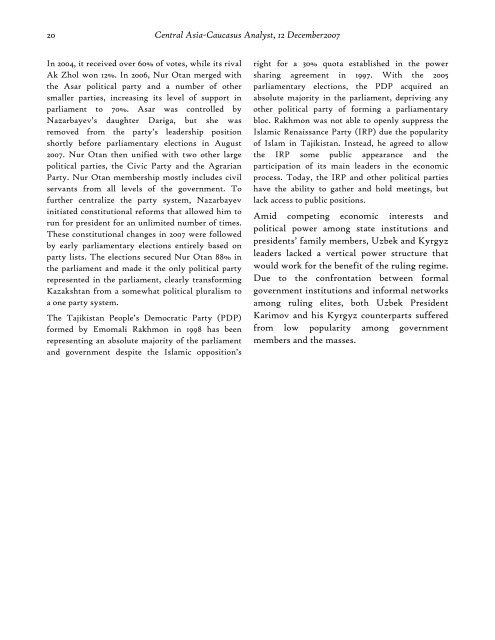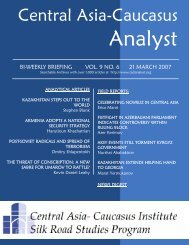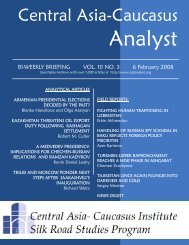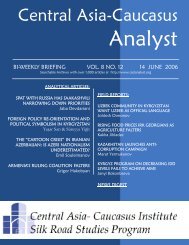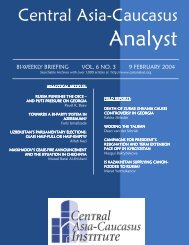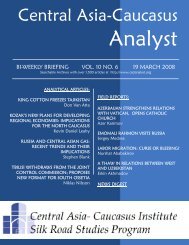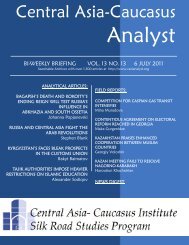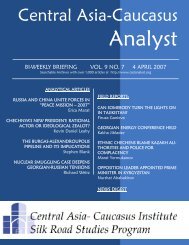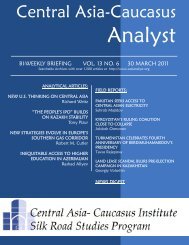20<strong>Central</strong> <strong>Asia</strong>-<strong>Caucasus</strong> <strong>Analyst</strong>, 12 December2007In 2004, it received over 60% of votes, while its rivalAk Zhol won 12%. In 2006, Nur Otan merged withthe Asar political party and a number of othersmaller parties, increasing its level of support inparliament to 70%. Asar was controlled byNazarbayev’s daughter Dariga, but she wasremoved from the party’s leadership positionshortly before parliamentary elections in August2007. Nur Otan then unified with two other largepolitical parties, the Civic Party and the AgrarianParty. Nur Otan membership mostly includes civilservants from all levels of the government. Tofurther centralize the party system, Nazarbayevinitiated constitutional reforms that allowed him torun for president for an unlimited number of times.<strong>The</strong>se constitutional changes in 2007 were followedby early parliamentary elections entirely based onparty lists. <strong>The</strong> elections secured Nur Otan 88% inthe parliament and made it the only political partyrepresented in the parliament, clearly transformingKazakshtan from a somewhat political pluralism toa one party system.<strong>The</strong> Tajikistan People’s Democratic Party (PDP)formed by Emomali Rakhmon in 1998 has beenrepresenting an absolute majority of the parliamentand government despite the Islamic opposition’sright for a 30% quota established in the powersharing agreement in 1997. With the 2005parliamentary elections, the PDP acquired anabsolute majority in the parliament, depriving anyother political party of forming a parliamentarybloc. Rakhmon was not able to openly suppress theIslamic Renaissance Party (IRP) due the popularityof Islam in Tajikistan. Instead, he agreed to allowthe IRP some public appearance and theparticipation of its main leaders in the economicprocess. Today, the IRP and other political partieshave the ability to gather and hold meetings, butlack access to public positions.Amid competing economic interests andpolitical power among state institutions andpresidents’ family members, Uzbek and Kyrgyzleaders lacked a vertical power structure thatwould work for the benefit of the ruling regime.Due to the confrontation between formalgovernment institutions and informal networksamong ruling elites, both Uzbek PresidentKarimov and his Kyrgyz counterparts sufferedfrom low popularity among governmentmembers and the masses.
<strong>Central</strong> <strong>Asia</strong>-<strong>Caucasus</strong> <strong>Analyst</strong>, 12 December 2007 21NEWS DIGESTAZERBAIJANI AND ARMENIAN FMS MEETIN MADRID29 NovemberForeign ministers Elmar Mammadyarov ofAzerbaijan and Vardan Oskanian of Armenia metThursday in Madrid, Spain, to discuss settlement ofthe Nagorno-Karabakh conflict. <strong>The</strong> meeting washeld in the presence of the OSCE Minsk Group cochairsas well as Russian Foreign Minister SergeyLavrov and US Under Secretary of State NicholasBurns. <strong>The</strong> meeting took place within theframework of the OSCE`s 15th Ministerial Council.(Azertag)OKRUASHVILI PLACED IN GERMANCUSTODY FOR 2 MONTHS, DENIEDPOLITICAL ASYLUM - GEORGIANAMBASSADOR29 NovemberFormer Georgian Defense Minister IraklyOkruashvili requested political asylum in Germanynearly a month before being arrested in Berlinyesterday, Georgian ambassador to Germany LevanDuchidze said.Okruashvili filed a formal request for politicalasylum on November 1, almost immediately uponhis arrival in Germany, Duchidze told GeorgianRustavi-2 television on Thursday. <strong>The</strong> Germanyauthorities cannot grant Okruashvili politicalasylum because he has not got a German visa,Duchidze said. After his arrest, Okruashvili has notasked for meetings with Georgian embassyofficials, the ambassador said. <strong>The</strong> Georgian side isin permanent contact with the Berlin Prosecutor'sOffice, he said. On Thursday, Okruashvili wastransferred to a pre-trial detention center after acourt ruled to place him in custody for two months,Duchidze said. If an upper court upholds the ruling,the Georgian authorities will have 40 days toprepare and submit extradition papers, he said.(Interfax)PRIME MINISTER OF KYRGYZSTANLEAVES OFFICE29 NovemberKyrgyzstan's president signed an order relievingPrime Minister Almazbek Atambayev of duty onWednesday, nine months after he was appointed ina move to appease opposition groups. <strong>The</strong> orderfollowed Atambayev's request to be relieved of thepost, said Nurlan Shakiyev, spokesman forPresident Kurmanbek Bakiyev. However, aspokesman for Atambayev's Social DemocraticParty, Edil Basailov, said Atambayev was fired"because he was interfering with efforts tomanipulate the upcoming elections" for Parliamentthat are set for Dec. 16. Bakiyev appointedAtambayev in February amid a political crisis inwhich opposition groups were calling for Bakiyev toresign over corruption and cronyism allegations. InMay, Atambayev lost consciousness for two daysand later claimed he had been poisoned. He said hehad received death threats connected with agovernment decision to nationalize a semiconductorplant. Politics in Kyrgyzstan _ where both Russiaand the United States have military air bases _ havebeen mired in squabbling for two years sinceBakiyev came to power in the wake of theoverthrow of longtime President Askar Akayev.(AP)“ROLE OF POLITICAL LEADERS INDEVELOPMENT OF TURKISH SPEAKINGNATIONS IN 20TH CENTURY”CONFERENCE DUE IN ALMATY30 November<strong>The</strong> second international conference “Role ofPolitical Leaders in Development of the TurkishSpeaking Nations in the 20th Century” organizedby the Bishkek-based Public Foundation in Supportof the Turkish-speaking Countries will take place inAlmaty, Kazakhstan on 12 December, AzerTAc owncorrespondent reports. <strong>The</strong> event is expected bring
- Page 1: Central Asia-CaucasusAnalystBI-WEEK
- Page 4 and 5: THE CENTRAL ASIA-CAUCASUS ANALYSTEd
- Page 6 and 7: 4Central Asia-Caucasus Analyst, 12
- Page 8 and 9: 6Central Asia-Caucasus Analyst, 12
- Page 10 and 11: 8Central Asia-Caucasus Analyst, 12
- Page 12 and 13: 10Central Asia-Caucasus Analyst, 12
- Page 14 and 15: 12Central Asia-Caucasus Analyst, 12
- Page 16 and 17: 14Central Asia-Caucasus Analyst, 12
- Page 18 and 19: 16Central Asia-Caucasus Analyst, 12
- Page 20 and 21: 18Central Asia-Caucasus Analyst, 12
- Page 24 and 25: 22Central Asia-Caucasus Analyst, 12
- Page 26 and 27: 24Central Asia-Caucasus Analyst, 12
- Page 28 and 29: 26Central Asia-Caucasus Analyst, 12
- Page 30: 28Central Asia-Caucasus Analyst, 12


